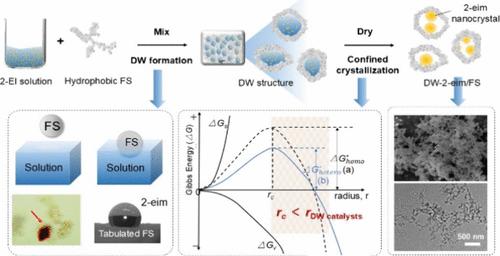当前位置:
X-MOL 学术
›
ACS Sustain. Chem. Eng.
›
论文详情
Our official English website, www.x-mol.net, welcomes your
feedback! (Note: you will need to create a separate account there.)
Dry-Water-System Confined Fabrication of Nanocuring Catalysts for Superior Low-Cure Powder Coating
ACS Sustainable Chemistry & Engineering ( IF 7.1 ) Pub Date : 2024-11-15 , DOI: 10.1021/acssuschemeng.4c06792 Xiao Lv, Haiping Zhang, Hui Zhang, Yuanyuan Shao, Jesse Zhu
ACS Sustainable Chemistry & Engineering ( IF 7.1 ) Pub Date : 2024-11-15 , DOI: 10.1021/acssuschemeng.4c06792 Xiao Lv, Haiping Zhang, Hui Zhang, Yuanyuan Shao, Jesse Zhu

|
Curing catalysts can accelerate cross-linking reactions but often deteriorate surface performance due to heterogeneous catalysis, which can be resolved by improved homogeneous dispersion of nanoscale catalysts and thus uniform catalysis of resin cross-linking reaction. Nonetheless, nanosizing solidified catalysts, typically organic small molecular crystals, presents challenges using conventional top-down and bottom-up methodologies. Herein, we present a straightforward approach to preparing nanocuring catalysts by leveraging the dry-water structure and obtaining high-performance low-temperature curing coatings. The stable dry-water structure, with microscale catalyst solution droplets surrounded with hydrophobic fumed silica, was formed. Confinement of fumed silica effectively limits the size of the organic catalyst crystals on the nanoscale by ensuring the low 2-eim content in the separated compartment. Coatings incorporating the obtained catalyst, cured at a lower temperature of 170 °C for 15 min, exhibit mechanical strength and chemical resistance compared to standard powder coatings cured at 190 °C for 15 min. Furthermore, with the improved uniform catalysis brought from the nanocatalyst, the low-temperature curing coatings demonstrate excellent surface performance, maintaining gloss levels comparable to the original powder coating film. This study delves into the mechanism of the dry-water structure, offering a facile approach for fabricating nanoscale curing catalysts and achieving high-quality surfaces in powder coating applications.
中文翻译:

用于卓越低固化粉末涂料的纳米固化催化剂的干水系统密闭制造
固化催化剂可以加速交联反应,但由于多相催化作用,通常会使表面性能恶化,这可以通过改进纳米级催化剂的均匀分散以及从而均匀催化树脂交联反应来解决。尽管如此,使用传统的自上而下和自下而上的方法对凝固催化剂(通常是有机小分子晶体)进行纳米化提出了挑战。在此,我们提出了一种简单的方法来制备纳米固化催化剂,方法是利用干水结构并获得高性能低温固化涂层。形成了稳定的干水结构,微尺度催化剂溶液液滴被疏水性气相二氧化硅包围。气相二氧化硅的限制通过确保分离室中的低 2-eim 含量,有效地限制了纳米级有机催化剂晶体的大小。与在 190 °C 固化 15 分钟的标准粉末涂料相比,掺入所得催化剂的涂料在 170 °C 的较低温度下固化 15 分钟,表现出机械强度和耐化学性。此外,随着纳米催化剂带来的改进的均匀催化,低温固化涂料表现出优异的表面性能,保持与原始粉末涂料膜相当的光泽度。本研究深入研究了干水结构的机理,为制造纳米级固化催化剂和在粉末涂料应用中实现高质量表面提供了一种简单的方法。
更新日期:2024-11-15
中文翻译:

用于卓越低固化粉末涂料的纳米固化催化剂的干水系统密闭制造
固化催化剂可以加速交联反应,但由于多相催化作用,通常会使表面性能恶化,这可以通过改进纳米级催化剂的均匀分散以及从而均匀催化树脂交联反应来解决。尽管如此,使用传统的自上而下和自下而上的方法对凝固催化剂(通常是有机小分子晶体)进行纳米化提出了挑战。在此,我们提出了一种简单的方法来制备纳米固化催化剂,方法是利用干水结构并获得高性能低温固化涂层。形成了稳定的干水结构,微尺度催化剂溶液液滴被疏水性气相二氧化硅包围。气相二氧化硅的限制通过确保分离室中的低 2-eim 含量,有效地限制了纳米级有机催化剂晶体的大小。与在 190 °C 固化 15 分钟的标准粉末涂料相比,掺入所得催化剂的涂料在 170 °C 的较低温度下固化 15 分钟,表现出机械强度和耐化学性。此外,随着纳米催化剂带来的改进的均匀催化,低温固化涂料表现出优异的表面性能,保持与原始粉末涂料膜相当的光泽度。本研究深入研究了干水结构的机理,为制造纳米级固化催化剂和在粉末涂料应用中实现高质量表面提供了一种简单的方法。


















































 京公网安备 11010802027423号
京公网安备 11010802027423号